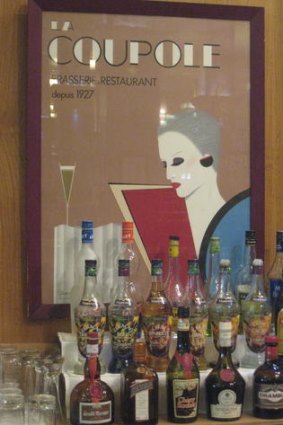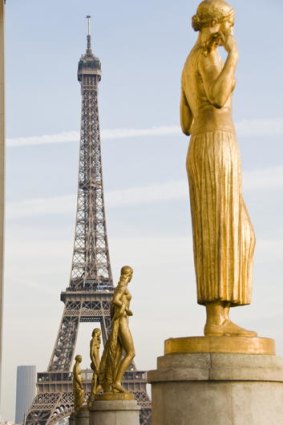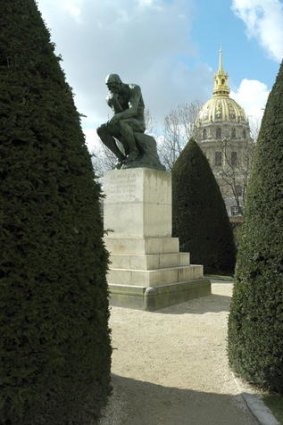
Artistic allure ... La Coupole.Credit: Margaret Turton
The charmed 1920s left an indelible mark on Paris, Margaret Turton discovers.
ONCE upon a time, when the US dollar was worth more than five French francs, moving to Paris was distinctly advantageous for creative types such as writers.
It was the 1920s. High living and bootleg liquor were taking their toll on Zelda and Scott Fitzgerald's health and finances. They headed for Paris, where Scott worked on the novel that became The Great Gatsby.
Ernest Hemingway was already residing on Rue Notre-Dame-des-Champs in Montparnasse. Nearby, on Rue de Fleurus, writer and patron of the arts Gertrude Stein lived in a plush apartment with her lover, Alice Toklas. Stein collected artworks, which led to creative types such as Hemingway introducing the Fitzgeralds to her world.
It is to this charmed decade – Paris in the roaring '20s – that modern-day dreamer Gil Pender, an aspiring novelist from Pasadena, finds himself transported in the Woody Allen movie Midnight in Paris.
So, what remains from that fabulous era today? Plenty, if you're willing to scratch the surface.

Palais de Chaillot.Credit: istock
First, there's the brasserie La Coupole, on Boulevard du Montparnasse, which was frequented by Hemingway and the Fitzgeralds in the late '20s, as well as by Stein, Pablo Picasso, Salvador Dali and Jean Cocteau.
These days the cavernous interior is sometimes likened to an enormous barn, though close inspection reveals that its 32 pillars were painted by selected artists, including Isaac Grunewald, who studied under Matisse.
Victor Robiquet was responsible for the portrait of another regular, African-American jazz singer and dancer Josephine Baker.

The Musee Rodin.Credit: Getty Images
There are cubist-inspired mosaics and vibrant murals that exude a joie de vivre that was indulged unchecked; a frenzied rage to live that made this postwar decade roar. Jazz, tango and salsa hit Paris hard and La Coupole's dance floor was chaotic. Corks popped on 1200 bottles of Mumm on its opening night in 1927.
They're popping still. It's just that subsequent clienteles have lacked that level of collective euphoria, the type of cross-cultural interaction capable of provoking such a huge outpouring of artistic ideas.
More examples can be seen at Le Vaudeville, a brasserie on Rue Vivienne. Here, the same bold style – now commonly called art deco – appears in mosaics and tiles, statues of gracefully striding ladies and etched-glass panels with geometric shapes that show the shift from the sinuous lines of art nouveau.
In 1925, the seafood restaurant Maison Prunier opened on Avenue Victor Hugo. Architect Louis-Hippolyte Boileau worked on the interiors and today the art deco room exudes the same style.
By 1937, Boileau was involved in the construction of the Palais de Chaillot for the Exposition Internationale des Arts et Techniques dans la Vie Moderne, last of the great world fairs held in Paris before the outbreak of another global war.
Palais de Chaillot is directly across the Seine from the Eiffel Tower. These days it's home to the Musee de l'Homme (under renovation) and the Musee de la Marine.
A short distance along the river bank, Palais de Chaillot's art deco sister, Palais de Tokyo, houses the Musee d'Art Moderne, which exhibits the big-name painters plus an impressive collection of deco furniture and decorative arts from the interwar period. These include a monumental panel entitled Les Sports, created by Jean Dunand for the trans-Atlantic ocean liner Normandie.
Boileau had just graduated from the Ecole des Beaux-Arts when he collaborated on Hotel Lutetia on Boulevard Raspail.
While the carvings on the 1910 facade reflect the voluptuous style of the turn of the century – the era known as the Belle Epoque – Hotel Lutetia's interiors looked towards the future and this is said to be Paris's first art deco hotel.
Picasso, Amedeo Modigliani and singer Baker were very much at home there. It is the Belle Epoque, however, that thoroughly charms the beautiful Adriana, another character in Midnight in Paris. Adriana belongs to the jazz age. She's the long-suffering mistress of Picasso and, before him, Georges Braque and Modigliani. Now she's falling for time-traveller Gil.
Adriana leads Gil back to her ideal era with its Moulin Rouge, cancan and absinthe. More importantly, for Adriana, the Belle Epoque is the era of true cultural refinement, a time when to suffer for love – or from tuberculosis – was perceived as deeply romantic.
And so, Allen takes the viewer on a trip through Paris, past and present. Gil's flights of fantasy begin at midnight on the steps near the church of Saint-Etienne-du-Mont at Place de l'Abbe-Basset.
And in between these journeys the viewer joins him in the gardens of the Musee Rodin. We see the monumental paintings of Musee de l'Orangerie, an art museum since 1927. We see the beautiful Pont Alexandre III, built for the Exposition Universelle of 1900. Then there's the antique market scene. This is Marche aux Puces de Saint-Ouen, the world's busiest flea market, with 2500 stands.
When Gil shops for books he's at the world's largest open-air bookshop. It stretches for three kilometres along the banks of the Seine, where there are 220 second-hand booksellers offering prints and books, antiquarian and modern.
Midnight or midday, Paris shines.
The writer was a guest of International Rail and the French Tourist Bureau.
Trip notes
Getting there
Six international railway stations connect Paris with London (by Eurostar) and all European cities. Book through Australian-owned International Rail. 1300 387 245, internationalrail.com.au.
Staying there
Hotel Lutetia, 45 Boulevard Raspail, is a four-star hotel in fashionable Saint-Germain-des-Pres. Rooms from €234 ($310). +33 1 49 54 46 10, lutetia-paris.com.
Eating there
La Coupole, 102 Boulevard du Montparnasse. Signature dishes, such as the lamb curry, are priced from €27.50 to €36.50. Various fixed-price menus start from €28. +33 1 43 20 14 20, lacoupole-paris.com.
Le Vaudeville, 29 Rue de Vivienne. A la carte dining plus fixed-price menus, which start from €26. +33 1 40 20 04 62, vaudevilleparis.com.
Maison Prunier, 16 Avenue Victor Hugo. Famous for its seafood, especially the caviar. Mains are priced from €35 for hot smoked Irish salmon with tomatoes and basil. The bouillabaisse a la Parisienne, inspired by a 1929 recipe, is €104 for two people. +33 1 44 17 35 85, prunier.com.
More information
See franceguide.com.
Sign up for the Traveller Deals newsletter
Get exclusive travel deals delivered straight to your inbox. Sign up now.